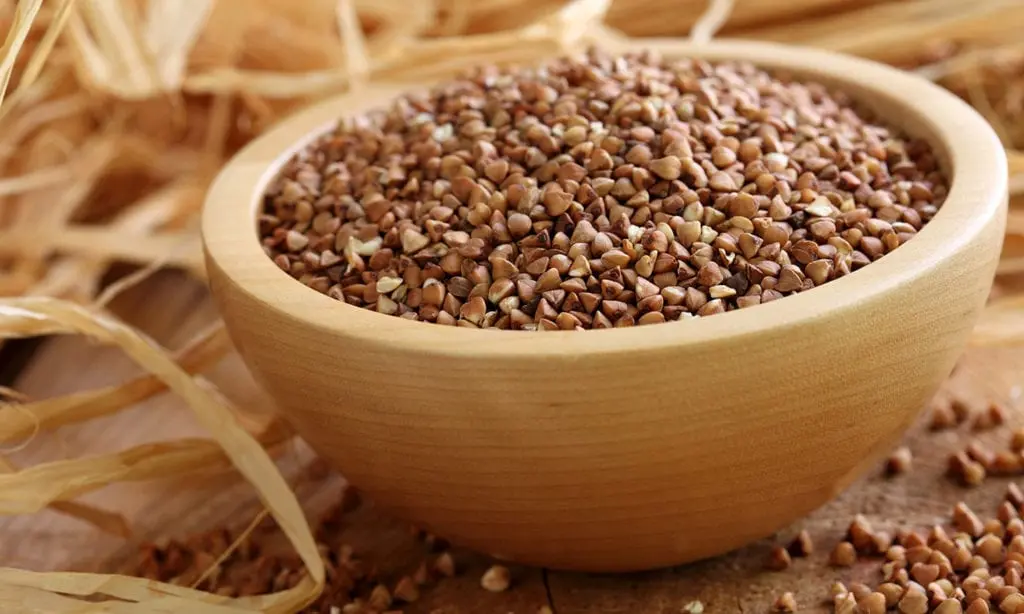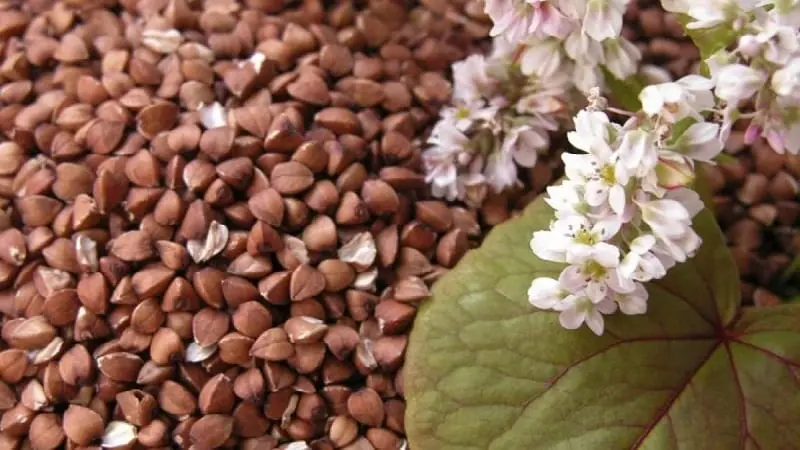Contents
Description
Buckwheat is a real symbol of healthy food, and it contains more than 50 valuable substances. This cereal is one of the leaders in vegetable protein content (more only in legumes). Moreover, the protein is well absorbed.
Buckwheat history
Buckwheat is the seeds of common buckwheat. The word “buckwheat” comes from an abbreviated version of “Greek groats” since it supposedly came to Russia from Greece.
The plant is widespread throughout the world and is considered an ancient culture. Its homeland is India and Nepal, where this cereal began to be specially grown 4 thousand years ago. Further, it was introduced to Asia, spread to the Middle East, and came to Europe around the 16th century.
Due to the active trade in buckwheat between different countries, it was called differently; for example, in Italy and Greece, “Turkish grain” and France and Portugal are “Arab.”

In India, buckwheat is still of great cultural importance. During the Navaratri religious festival, Hindus can eat only certain vegetables, buckwheat, and other cereals. And in Nepal, buckwheat seeds are dried and gnawed as a snack, as we have sunflower seeds.
This cereal is also considered an important honey plant – the famous honey with a peculiar smell and taste is made from buckwheat nectar.
The composition and calorie content of buckwheat
The seed of the plant contains a large amount of protein, which is typical for all cereal crops. But its proteins are special. They contain an increased amount of special amino acids – lysine and methionine, which make them very easily absorbed.
- Caloric content 308 kcal
- Proteins 12.6 g
- Fat 3.3 g
- Carbohydrates 57.1 g
The benefits of buckwheat

Buckwheat is one of the richest in protein cereals. In this sense, it is second only to peas. Buckwheat proteins contain many amino acids: lysine, tryptophan, which are necessary for the synthesis of their own proteins in the body. Therefore, buckwheat is of such great importance for vegetarians as a partial replacement for meat food.
Also, buckwheat is rich in starch – a carbohydrate that feeds the body. The fiber in the composition gives a long feeling of satiety, so this cereal is a favorite of many diets. With constipation, the same fiber helps to increase peristalsis and improve digestion. Although in large quantities, buckwheat has the opposite effect.
Buckwheat is one of the few bowls of cereal that contain choline, a B vitamin essential for the nervous system to function. Some scientists believe that this cereal even reduces the risk of cancer due to its high concentration of flavonoids. These substances inhibit the growth of cancer cells.
Buckwheat contains many other B vitamins and fat-soluble vitamins E and K, which are absorbed only together with fats.
Buckwheat harm

With moderate consumption of buckwheat, usually, there are no problems. For some people, these grains causes allergic reactions.
In large quantities, buckwheat can increase constipation if a person is prone to this. On the contrary, after food poisoning, buckwheat is a rather “easy” product to start eating again.
The use of buckwheat in medicine
The benefits of this cereal in nutrition are invaluable. Especially known are “buckwheat diets,” in which they eat one buckwheat and kefir. Of course, any mono-diet is extremely harmful since it does not provide the body with all the necessary substances. But if you include buckwheat in your main diet, it really helps you lose weight. Cereal provides the body with proteins, and the feeling of hunger does not arise so quickly.
In classical medicine, many preparations are made based on cereal. Simultaneously, many parts of the plant are harvested: flowers, leaves, and stems. Pharmacists get the substance rutin from the herbaceous part, and flowers are used to produce herbal preparations. Rutin is used to treat vitamin P deficiency and improve vascular permeability, which is impaired in many diseases – hypertension, rheumatism, and others.

Buckwheat is also known in folk medicine. They drank a decoction of buckwheat flowers from a dry cough with bronchitis. The broth also facilitates the expectoration process. Chopped dry or fresh leaves help heal purulent wounds and sores.
Buckwheat seeds are interestingly used in oriental medicine. Dry cereal is supplemented with therapeutic massage sessions: bags with cereals are heated and then laid out on problem points. Even heat improves tissue blood flow and reduces pain. In cosmetology, coarse buckwheat flour is added to scrubs and peels to cleanse the skin.
Types and varieties
The agricultural crop from which the well-known cereals are produced is called “buckwheat.” This word should not be confused with the colloquial name of cereals – “buckwheat.”
In the cuisine of Asian countries and traditional cereals and flour from it, shoots and their leaves are also used, which are fried, added to salads, soups, and meat dishes as a seasoning. With the help of this amazing plant, you can get honey and remove weeds from the garden since buckwheat belongs to siderites – crops that displace others.
In most countries of the world, it is customary to use its grains for culinary purposes, which are angular seeds painted in different brown tones. The degree of color saturation indicates the way buckwheat is processed. She may be:

- greenish – natural, not subjected to heat treatment;
- light brown – steamed;
- reddish brown – fried.
The latter has the longest shelf life, and natural buckwheat will be the most useful. When purchasing it in retail chains, you should prefer the middle version, which has an optimal ratio of nutritional value and shelf life.
Taste qualities
The taste of crumbly buckwheat porridge is familiar to everyone from childhood. It is not difficult to prepare it if you follow simple rules. It often harms the taste of this cereal if the proportions of cereal and water are not observed. They should correlate with each other, like 1: 2. Do not pour water; it should be steamed rather than boiled, for which it is also important to close the lid of the dish tightly. In the event of a lack of water, the porridge may burn.
The ability of cereals to absorb odors well can also affect the taste of dishes made from them. Even buckwheat partially adhering to the bottom of the pan will be completely spoiled by the burnt smell. But thanks to this same property, you can pleasantly diversify the usual-tasting buckwheat with various additives: butter, fried onions with carrots, bacon, or cracklings.
Cooking applications

Being one of the most popular cereals is very popular among chefs in all forms:
- boiled unground, used in soups, stuffed with geese, ducks, and suckling pigs;
- viscous milk porridge, casseroles, and cutlets are prepared from the product;
- the flour is added to baked goods, used for making pancakes and fritters.
Loose buckwheat can be a side dish for various meat and fish dishes or serve as an independent dish with all additives. It goes best with fried vegetables, mushrooms, poultry stews, boiled eggs, and goulash. No less popular buckwheat dish for people of all ages is milk porridge with butter, to which you can also add honey, raisins, and other dried fruits.
How to choose and store buckwheat
There are several types of this cereal. The most useful and unprocessed is green. This is the primary product in the form in which buckwheat is harvested. It is commonly consumed by vegetarians in a sprouted raw form, although the taste may seem rather unusual.
Fried dry cereal turns brown, acquires a different taste. It is called a kernel. Crushed ungrounds are sold under the name “buckwheat propel.” It cooks much faster but contains fewer nutrients. The steamed-flattened grains become flakes, which are convenient for a quick breakfast.
Regardless of which cereal you choose, it should be dry, odorless, moldy, and musty. Also, check the bag for bug bugs. Thus, it is better to buy prepackaged buckwheat – parasites are less likely to grow in it.
Store cereals in a tightly sealed container, jar, or container in a dark place. If all conditions are met, the croup can lie for several years.










